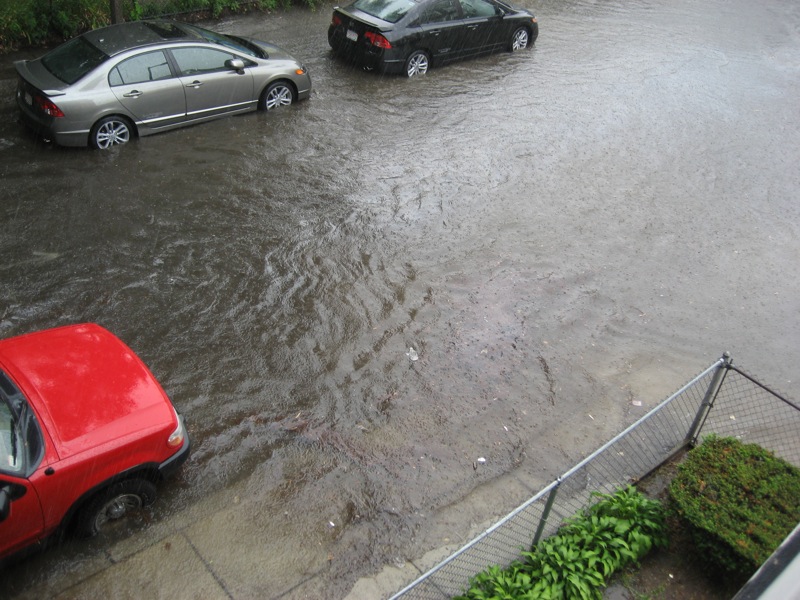Last week, Las Vegas experienced heavy rain showers and thunderstorms with flash flood warnings. The monsoon hit the city on Thursday night and the extreme weather continued through Sunday afternoon. The National Weather Service warned of thunderstorms and rain in Las Vegas, as well as Henderson, Mesquite, and Boulder City. Thousands lost power and many trees were blown down in several parts of the valley. Not only did this incident impact the strip, casinos, and the airport, it also impacted the roads and safety of residents.
Flooding on The Strip
The famed casinos and the Strip, filled with tourists during the summer break, were not spared from the storm and several casinos saw power outages and flooding. A vacationer at Planet Hollywood described the experience as frightening and shocking, stating that there was water gushing from the ceiling onto gaming tables, later resulting in falling debris and panic from people that the ceiling would cave in. In addition to the casinos, The American Red Cross of Nevada reported that more than 30 residents were displaced due to the high winds knocking trees into an apartment building. [1]
Planet Hollywood wasn’t the only casino to see flooding and videos posted all over Tik Tok and other social media platforms showed water seeping from light fixtures in Caesars Palace, downtown streets turning into small rivers, and the water and thunder rising near Harry Reid International Airport causing flight delays.
Megan Poff from the Nevada Water Science Center and the US Geological Survey told Insider that while monsoon season is typically through July and September in Nevada, it is unusual that the storm landed directly on the strip. Vegas saw over one inch of rain, a rare occurrence considering the usual dryness and dessert-like conditions. This was also rare considering the city only receives about four inches of rain in total per year
Driving During Flash Floods and Severe Weather
Many Las Vegas Residents are not accustomed to driving in extremely rainy conditions and flash flooding can pose a danger to drivers. Heavy rain and the high winds associated with flash flooding can be extremely dangerous to drive in and it is always best to avoid doing so. However, if it is necessary to do so, ensure to do the following:
- Drive with your headlights on using the low beams
- Avoid driving through still water and roads that appear flooded. While the water may look shallow, the water can damage and disable your vehicle. Additionally, floodwaters can rise very quickly.
- Increase your following distance as well as the space between your vehicle and others. This will give you enough time to gage and respond to other drivers’ moves
- Reducing Speed: increased speed reduces tire traction on wet roads
- Don’t use cruise control
- If your vehicle begins to hydroplane, take your foot off the accelerator slowly and keep the steering wheel as straight as you can.
If you are driving in flash flooding, there is a chance that the vehicle can stall. If this happens do not remain in your car, and instead abandon your vehicle and move to higher ground. Flood waters often rise quick and can cause the vehicle to get swept away. You can take some extra measures beforehand to help prevent your car from flooding. This includes not leaving your car under power lines or trees, keeping your car on an elevated surface or in a garage to keep it protected from wind or other damages, and to use a flood cover that can help protect the car from water damages. You can also prepare your vehicle for bad weather by checking tire pressure and tread, as well as keeping the gas tank substantially full and checking all fluid levels. It is also important to having working windshield wipers that do not leave streaks or missing spots. Packing an emergency kit in your vehicle may also be smart and it would be best to include flashlight, extra batteries, first aid kits, etc.
Turn Around Don’t Drown
The CDC has reported that half of all flood-related drownings occurs when a vehicle drives into dangerous flood water, while the next highest occurred due to walking into flood water. [3] Water can be forceful and powerful even though it appears manageable, and automobiles and people can be swept downstream quickly. Six inches of fast-moving water can knock over an adult while just twelve inches can carry away a car, and two feet can take away almost any vehicle. Many drownings are preventable if people are cautious and avoid driving through closing off barriers on flooded streets or by not listening to officials who advise residents to stay home. These events happen every year, so the prudent choice is to not drive when flash floods are prevalent.
[2] https://go.carolinas.aaa.com/expert-advice/weather/flash-flood-driving-tips-and-prepping-vehicles-for-bad-weather-50059
[3] https://www.weather.gov/safety/flood-turn-around-dont-drown
Image Credit: Adam Pieniazek


